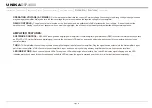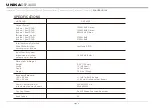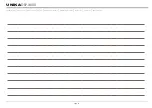
Introduction Front Panel Rear Panel
Speakon Assembly Operating Modes Protection Features Specifications
Set Up
INPUTS -
The DSP-4000 amplifier allows you to use two types of input connectors per channel, a XLR female jack for balanced connections
and a 1/4” TRS female jack that will accept balanced and unbalanced connectors. Use these connections to connect the output signal from a
mixer, cross-over or EQ to your
DSP-4000
amplifier. A balanced connection is recommended for cable runs longer than 20ft. When constructing
your own XLR cables follow the pin configuration described below for proper connections. For cable runs shorter than 20ft., you may choose the
1/4” TS unbalanced input option. The 1/4” TS unbalanced input option may be more convenient for most users due to the abundant supply of
prefabricated cables available at your local audio dealer.You may use the two XLR “Input Thru” jacks to jump a parallel connection to another
amplifier or other device. For example: Connect a XLR cable to the input of channel one. You may now connect a XLR cable from the channel
one “Input Thru” jack to the input jack of another amplifier's channel one input. This will reduce the use of “Y” cables.
OUTPUTS -
BINDING POST/BANANA PLUG:
Connect your speakers to the binding post outputs on the rear of the amplifier. The
speaker wire may be connected by bare wire (directly connected, usually for permanent connections), banana plug, or
spade connector. Connections are made to channel one and channel two outputs for Stereo Mode or across the red
terminals of channel one and channel two for Mono Bridge Mode.
IMPORTANT NOTICE:
Although a speaker will operate with the positive and negative leads plugged into either terminal
on the amplifier binding post, be sure to plug the negative lead into the black terminal and positive lead into the red
terminal. Ensuring proper polarity will avoid speakers being out of phase that can cause a loss of bass response.
Figure
6
2 Hot (+data)
1
3
2
Male
XLR
Pin
Configuration
Figure
3
1 Ground / Return / 0v
3 Negative (-data)
Balanced TRS 1/4” Plug
Hot (+)
Negative (-)
Ground/Shield
Figure
4
Unbalanced TS 1/4” Plug
Hot (+)
Negative (-)
Figure
5
page 5
SET UP
UNiKA
DSP-4000
































